Birmingham, Alabama, Hgh State Clinic, Hgh Injections, Hrt Doctors
Birmingham, Alabama Blood Testing Facilities
 Represents a LabCorp blood testing facility
Represents a LabCorp blood testing facility Represents a Quest Diagnostics blood testing facility
Represents a Quest Diagnostics blood testing facility

Nearby Labcorp Blood Testing facilities:
- Labcorp Center Distance: 3 m, 790 Montclair Road, Birmingham, Jefferson County, AL, 35213
- Labcorp Center Distance: 4 m, 2022 Brookwood Medical Ctr Dr Ste 401, Birmingham, Jefferson County, AL, 35209
- Labcorp Center Distance: 11 m, 2217 Decatur Hwy, Gardendale, Jefferson County, AL, 35071
- Labcorp Center Distance: 13 m, 153 Narrows Pkwy Ste 202, Birmingham, Shelby County, AL, 35242
- Labcorp Center Distance: 33 m, 3400 Highway 78 E Ste 103, Jasper, Walker County, AL, 35501
- Labcorp Center Distance: 40 m, 209 W Spring St Suite 105, Sylacauga, Talladega County, AL, 35150
- Labcorp Center Distance: 46 m, 902 Dr Edward Hillard Dr., Tuscaloosa, Tuscaloosa County, AL, 35401
- Labcorp Center Distance: 48 m, 1890 Al Hwy 157 Pob 11 220B, Cullman, Cullman County, AL, 35058
- Labcorp Center Distance: 57 m, 302 S 4Th St, Gadsden, Etowah County, AL, 35901
- Labcorp Center Distance: 62 m, 320 Branscomb Dr Sw Suite C, Jacksonville, Calhoun County, AL, 36265
- Labcorp Center Distance: 76 m, 103 Samuel O Moseley Dr, Selma, Dallas County, AL, 36701
- Labcorp Center Distance: 82 m, 333 Whitesport Dr Sw Ste 202, Huntsville, Madison County, AL, 35801
- Labcorp Center Distance: 84 m, 301 Governors Dr Sw Suite 110, Huntsville, Madison County, AL, 35801
- Labcorp Center Distance: 85 m, 4135 Atlanta Hwy Suite Z, Montgomery, Montgomery County, AL, 36109
- Labcorp Center Distance: 86 m, 225-A Winton Blount Loop, Montgomery, Montgomery County, AL, 36117
- Labcorp Center Distance: 89 m, 1878 Jeff Rd. Ste F, Huntsville, Madison County, AL, 35806
- Labcorp Center Distance: 93 m, 3543 Bluecutt Rd, Columbus, Lowndes County, MS, 39705
- Labcorp Center Distance: 99 m, 1518-B Professional Pkwy, Auburn, Lee County, AL, 36830
Nearby Quest Blood Testing facilities:
- Quest Center Distance: 4 m, 513 Brookwood Blvd, Suite 506, Birmingham, US, AL, 35209-6892
- Quest Center Distance: 46 m, 300 Towncenter Blvd, Tuscaloosa, Tuscaloosa County, AL, 35406-1842
- Quest Center Distance: 57 m, 601 S 4Th St, Gadsden, Etowah County, AL, 35901-5218
- Quest Center Distance: 74 m, 1501 7Th St Se, Decatur, Morgan County, AL, 35601-3378
- Quest Center Distance: 82 m, 250 Chateau Drive, Huntsville, Madison County, AL, 35801-3497
- Quest Center Distance: 84 m, 806 Governors Dr Sw, Huntsville, Madison County, AL, 35801-5133
- Quest Center Distance: 87 m, 7065 Sydney Curve, Montgomery, Montgomery County, AL, 36117-7101
Birmingham Alabama Hormone Replacement Therapy Services
Have you ever considered the benefits of Hormone Restoration? Do you feel like your body and mind just aren't functioning like they used to? Hormones are the primary chemical messengers of the human body, and maintain physiological homeostasis. Hormone Balance is one of the keys to staying healthy as you grow older, and Hormone Imbalance has a powerful impact on the body's ability to support and sustain itself.
The Conscious Evolution Institute specializes in health issues related to Hormone Imbalance and Decline, and is open to patients across the United States that are at least thirty years of age. We are Board-Certified and Licensed to engage in Hormone Restoration Services, and we have affiliate specialists across the nation that can provide us with the vital medical data that we need to set your health and your life on the right track! If you'd like to learn more about what we do and how we can potentially improve your life and your health, please call the number that you see on this page, or fill out the form on this page in order to talk to one of our friendly HRT Specialists!
Birmingham Alabama HGH Hormone Clinics for Growth Hormone Therapy
It is becoming increasingly clear that Age-Associated Human Growth Hormone Deficiency, also known as Somatopause, is a major contributor to declining health and wellness across the United States. HGH Deficiency is related to a large number of interconnected symptoms which reduce health and wellness and impede quality of life, including weakened immune system, reduced cognitive function, fuzzy memory, loss of muscle mass, increased BMI, impaired healing capacity, and even thinning hair.
With Bio-Identical HGH Injection Therapy, it is possible to boost suppressed Growth Hormone Levels back into the normal range, thus supporting the normal and healthy function of the human body. If you are interested in Buying HGH Online, we are a legal and reputable source for quality Human Growth Hormone Products and diagnostic services.
Birmingham Alabama Testosterone Restoration Therapy for Hypogonadism
Have you been feeling down and out in the bedroom? Do you feel tired and exhausted, like you are totally drained of energy? There is a real and significant chance that you are suffering from the effects of Testosterone Deficiency, and the Conscious Evolution Institute is here to help.
Our trained Testosterone Specialists can help you discover if you are suffering from Low-T, and treat you with high-quality Testosterone Treatments, including Low-T Patches, Testosterone Deficiency Creams, and highly effective Testosterone Injections. We can deliver Testosterone Products directly to your home and help you get back in the saddle again!
Birmingham Alabama Sermorelin HGH Therapy Alternative
For patients looking for an affordable alternative to Growth Hormone, Sermorelin is the best option available to date. Sermorelin provides the same net-result of restoring Growth Hormone Levels, but does so by encouraging the pituitary gland to produce its own natural HGH. Whereas Growth Hormone Injection Therapy replaces the body's endogenous HGH, Sermorelin stimulates the normal production of the Hormone.
For the majority of patients with Age-Related Growth Hormone Deficiency, Sermorelin is just as effective as Recombinant Growth Hormone while also maintaining more natural rhythms of Hormone Release. Sermorelin is less expensive than HGH while also being available for off-label prescription.
Birmingham Alabama Information
Birmingham is located in central Alabama and represents the most populous metropolitan area in the state. Historically well-known for being a major player in the late-19th and 20th century steel industry, Birmingham was established in 1871, in the years following the Civil War. The area around Birmingham was chosen because it offered everything needed to make high quality steel: coal, limestone, iron ore, and a water source (the Cahaba River). In addition to those factors, a railroad also crossed through the landscape, tying the city into the greater regional economy.
Birmingham was one of the preeminent boomtowns of the early 20th century south, and was a notable city for the arts during the same period. The city became the focal point of the Civil Rights movement in the 1950s and 1960s, and the city gained a notorious image for the atrocities commited during the period. Over the past fifty years, however, the city has grown and evolved to become a stronger and more inclusive community, though there is much work still to be done.
Neighborhoods in Birmingham include Glen Iris, Avondale, Highland Park, Downtown, Southside, Five Points, and Woodlawn. Suburbs of Birmingham include Trussville, Hoover, Homewood, Vestavia Hills, and Mountain Brook.
Birmingham Alabama Economy and Jobs
The Birmingham job market revolves heavily around health, education, and finance. The largest employer in the city of Birmingham, as well as the entire state of Alabama, is the University of Alabama-Birmingham. The school hosts one of the best hospital systems in the United States, and also has high-quality business and engineering programs. Other major employers in Birmingham include BBVA Compass, Regions Bank, and St. Vincent Hospital. In addition to UAB, Birmingham Southern is another University located in Birmingham. Samford University was established in nearby Homewood Alabama.
Things to Do in Birmingham Alabama
Birmingham is a city on the rise, and there are lots of fun things to do in the city. The most iconic landmark in Birmingham Alabama is Vulcan, the heaviest cast-iron statue ever made, which rests upon Red Mountain. One of the most popular landmarks in Birmingham is Railroad Park, a large park in the center of the city which has lots of room to roam, as well as plenty of designed space for events. Next to Railroad Park is Regions Field, where the local minor league baseball team the Birmingham Barons call their home.
There are many beautiful theaters in the city of Birmingham, including the newly-restored Lyric Theater, Carver Theater (relevant to the Civil Rights Movement), the Alabama Theater, and the Virginia Samford Theater. There are also many amazing music venues in Birmingham, including Saturn, Zydeco, Iron City, and Workplay. Birmingham is one of the best cities for the arts in the state of Alabama, and is home to the Birmingham Museum of Art.
Birmingham was also one of the central locations of the Civil Rights movement, and is home to major civil rights landmarks such as the Civil Rights Museum and the 16th Street Baptist Church.
All About Birmingham, Alabama Geographic Area
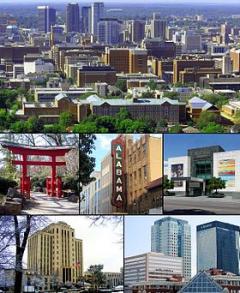
Birmingham ( /ËnbÉurmɪÅohR¦m/ BUR-ming-ham) is the largest city in Alabama. The city is the county seat of Jefferson County. The city's population was 212,237 according to the 2010 United States Census. The Birmingham-Hoover Metropolitan Area had a population of about 1,128,047 according to the 2010 Census, which is approximately one-quarter of Alabama's population.
/ËnbÉurmɪÅohR¦m/ BUR-ming-ham) is the largest city in Alabama. The city is the county seat of Jefferson County. The city's population was 212,237 according to the 2010 United States Census. The Birmingham-Hoover Metropolitan Area had a population of about 1,128,047 according to the 2010 Census, which is approximately one-quarter of Alabama's population.
Birmingham was founded in 1871, during the post-Civil War Reconstruction period, through the merger of three pre-existing farm towns, notably, former Elyton. It grew from there, annexing many more of its smaller neighbors, into an industrial and railroad transportation center with a focus on mining, the iron and steel industry, and railroading. Birmingham was named for Birmingham, one of the major industrial cities of the United Kingdom. Many, if not most, of the original settlers who founded Birmingham were of English ancestry. In one writer's view, the city was planned as a place where cheap, non-unionized, and African-American labor from rural Alabama could be employed in the city's steel mills and blast furnaces, giving it a competitive advantage over industrial cities in the Midwest and Northeast.
From its founding through the end of the 1960s, Birmingham was a primary industrial center of the South. The pace of Birmingham's growth during the period from 1881 through 1920 earned its nicknames The Magic City and The Pittsburgh of the South. Much like Pittsburgh, Birmingham's major industries were iron and steel production, plus a major component of the railroading industry, where rails and railroad cars were both manufactured in Birmingham. In the field of railroading, the two primary hubs of railroading in the Deep South were nearby Atlanta and Birmingham, beginning in the 1860s and continuing through to the present day. The economy diversified during the later half of the twentieth century. Though the manufacturing industry maintains a strong presence in Birmingham, other businesses and industries such as banking, telecommunications, transportation, electrical power transmission, medical care, college education, and insurance have risen in stature. Mining in the Birmingham area is no longer a major industry with the exception of coal mining. Birmingham ranks as one of the most important business centers in the Southeastern United States and is also one of the largest banking centers in the United States. In addition, the Birmingham area serves as headquarters to one Fortune 500 company: Regions Financial. Five Fortune 1000 companies are headquartered in Birmingham.
In the field of college and university education, Birmingham has been the location of the University of Alabama School of Medicine (formerly known as the Medical College of Alabama) and the University of Alabama School of Dentistry since 1947, and since that time, it has also become provided with the University of Alabama at Birmingham (founded circa 1969), one of three main campuses of the University of Alabama, and also with the private Birmingham-Southern College. Between these two universities and Samford University, the Birmingham area has major colleges of medicine, dentistry, optometry, pharmacy, law, engineering, and nursing. Birmingham is home to three of the state's five law schools: Cumberland School of Law, Birmingham School of Law, and Miles Law School. Birmingham is also the headquarters of the Southeastern Conference, one of the major U.S. collegiate athletic conferences.
Birmingham was founded on June 1, 1871, by the Elyton Land Company whose investors included cotton planters, bankers and railroad entrepreneurs. It sold lots near the planned crossing of the Alabama & Chattanooga and South & North Alabama railroads including land formerly a part of the Benjamin P. Worthington Plantation. The first business at that crossroads was the trading post and country store operated by Marre & Allen. The site of the railroad crossing was notable for the nearby deposits of iron ore, coal, and limestone ae the three main raw materials used in making steel. Birmingham is the only place worldwide where significant amounts of all three minerals can be found in close proximity. From the start the new city was planned as a great center of industry. The founders, organized as the Elyton Land Company, borrowed the name of Birmingham, one of England's main industrial cities, to advertise that point. The growth of the planned city was impeded by an outbreak of cholera and a Wall Street crash in 1873. However, it began to grow shortly afterward at an explosive rate.
The town of Elyton, Alabama, and several other surrounding towns were absorbed into Birmingham in 1911.
The turn of the 19th to 20th century brought the substantial growth that gave Birmingham the nickname "The Magic City" as the downtown area developed from a low-rise commercial and residential district into a busy grid of neoclassical mid-rise and high-rise buildings and busy streetcar lines. Between 1902 and 1912 four large office buildings were constructed at the intersection of 20th Street, the central north aesouth spine of the city, and 1st Avenue North, which connected the warehouses and industrial facilities stretching along the east aewest railroad corridor. This impressive group of early skyscrapers was nicknamed "The Heaviest Corner on Earth".

The Great Depression hit Birmingham especially hard as sources of capital that were fueling the city's growth rapidly dried up at the same time that farm laborers, driven off the land, made their way to the city in search of work. New Deal programs made important contributions to the city's infrastructure and artistic legacy, including such key improvements as Vulcan's tower and Oak Mountain State Park.
The wartime demand for steel and the post-war building boom gave Birmingham a rapid return to prosperity. Manufacturing diversified beyond the production of raw materials and major civic institutions such as schools, parks and museums, were able to expand their scope.
In the 1950s and 1960s Birmingham received national and international attention as a center of the civil rights struggle for African-Americans. Locally the movement's activists were led by Fred Shuttlesworth, a fiery preacher who became legendary for his fearlessness in the face of violence, notably a string of racially motivated bombings that earned Birmingham the derisive nickname "Bombingham".
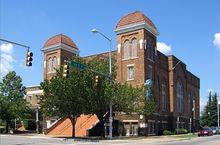
A watershed in the civil rights movement occurred in 1963 when Shuttlesworth requested that Martin Luther King, Jr., and the Southern Christian Leadership Conference (SCLC), which Shuttlesworth had co-founded, come to Birmingham, where King had once been a pastor, to help end segregation. Together they launched "Project C" (for "Confrontation"), a massive assault on the Jim Crow system. During April and May daily sit-ins and mass marches organized and led by movement leader James Bevel were met with police repression, tear gas, attack dogs, fire hoses, and arrests. More than 3,000 people were arrested during these protests, almost all of them high-school age children. These protests were ultimately successful, leading not only to desegregation of public accommodations in Birmingham but also the Civil Rights Act of 1964.
While imprisoned for having taken part in a nonviolent protest, Dr. King wrote the now famous Letter from Birmingham Jail, a defining treatise in his cause against segregation. Birmingham is also known for a bombing which occurred later that year, in which four black girls were killed by a bomb planted at the 16th Street Baptist Church. The event would inspire the African-American poet Dudley Randall's opus, "The Ballad of Birmingham", as well as jazz musician John Coltrane's song "Alabama".
In 1998 the Birmingham Pledge, written by local attorney James Rotch, was introduced at the Martin Luther King Unity Breakfast. As a grassroots community commitment to combating racism and prejudice, it has since then been used for programs in all fifty states and in more than twenty countries. In 2011, the Highland Park neighborhood of Birmingham was named as a 2011 America's Great Place by the American Planning Association.
In the 1970s urban-renewal efforts focused around the development of the University of Alabama at Birmingham, which developed into a major medical and research center. In 1971 Birmingham celebrated its centennial with a round of public-works improvements, including the upgrading of Vulcan Park. Birmingham's banking institutions enjoyed considerable growth as well and new skyscrapers started to appear in the city center for the first time since the 1920s. These projects helped the city's economy to diversify, but did not prevent the exodus of many of the city's residents to independent suburbs. In 1979 Birmingham elected Dr. Richard Arrington Jr. as its first African-American mayor.
The population inside Birmingham's city limits has fallen over the past few decades, due in large part to "white flight" from the city of Birmingham proper to surrounding suburbs. The city's formerly most populous ethnic group, non-Hispanic white, has declined from 57.4 percent in 1970 to 21.1 percent in 2010. From 340,887 in 1960, the population was down to 242,820 in 2000, a loss of about 29 percent. By 2009 Census estimates placed Birmingham's population at 230,650. That same period saw a corresponding rise in the populations of the suburban communities of Hoover, Vestavia Hills, Alabaster, and Gardendale, none of which were incorporated as municipalities until after 1950.
Today, Birmingham has begun to experience something of a rebirth. New resources have been dedicated in reconstructing the downtown area into a 24-hour mixed-use district. The market for downtown lofts and condominiums has increased while restaurant, retail and cultural options are also beginning to expand. In 2006, the visitors bureau selected "the diverse city" as a new tag line for the city.
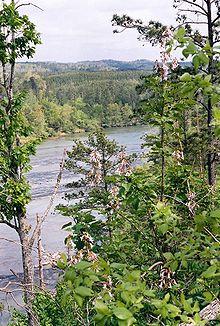
Birmingham occupies Jones Valley, flanked by long parallel mountain ridges (the tailing ends of the Appalachian foothills ae see Ridge-and-Valley Appalachians) running from north-east to south-west. The valley is drained by small creeks (Village Creek, Valley Creek) which flow into the Black Warrior River. The valley was bisected by the principal railroad corridor, along which most of the early manufacturing operations began.
Red Mountain lies immediately south of downtown. Many of Birmingham's television and radio broadcast towers are lined up along this prominent ridge. The "Over the Mountain" area, including Shades Valley, Shades Mountain and beyond, was largely shielded from the industrial smoke and rough streets of the industrial city. This is the setting for Birmingham's more affluent suburbs of Mountain Brook, Vestavia Hills, Homewood, and Hoover. South of Shades Valley is the Cahaba River basin, one of the most diverse river ecosystems in the United States.
Sand Mountain, a smaller ridge, flanks the city to the north and divides Jones Valley from much more rugged land to the north. The Louisville and Nashville Railroad (now CSX Transportation) enters the valley through Boyles Gap, a prominent gap in the long low ridge.
Ruffner Mountain, located due east of the heart of the city, is home to Ruffner Mountain Nature Center, one of the largest urban nature reserves in the United States.
According to the U.S. Census Bureau, the city has a total area of 151.9 square miles (393 km2), of which, 149.9 square miles (388 km2) of it is land and 2.0 square miles (5.2 km2) of it (1.34%) is water.
Birmingham has a humid subtropical climate, characterized by hot summers, mild winters, and abundant rainfall. January sees average highs in the low to mid 50s °F (10 ae13 °C), with lows just above freezing, falling to that point on 55 nights per year. In July temperatures are in the low 90s °F (32 ae34 °C), with lows averaging around 70 °F (21.1 °C); highs exceed 90 °F (32.2 °C) on 58 days per year and 100 °F (37.8 °C) on 2 or 3. Precipitation is relatively well-distributed throughout the year, sometimes falling in the form of snow during winter; however, 10.3 inches (26.2 cm) fell on March 13, 1993, during the 1993 Storm of the Century, which left the highest one-storm and daily snowfall total.
The spring and fall months are pleasant but variable as cold fronts frequently bring strong to severe thunderstorms and occasional tornadoes to the region. The fall season features less rainfall and fewer storms, as well as lower humidity than the spring, but it is also a secondary severe weather season. Birmingham is located on the heart of a Tornado Alley known as the Dixie Alley due to the frequency of tornadoes in Central Alabama. The greater Birmingham area has been hit by two F5 tornadoes; one in Birmingham's northern suburbs in 1977, and second in the western suburbs in 1998. The area has been hit by an EF4 tornado in 2011. In late summer and fall months, Birmingham experiences occasional tropical storms and hurricanes due to its proximity to the Central Gulf Coast.
The record high temperature is 107 °F (41.7 °C), set on July 29, 1930, and the record low is na6 °F ( na21.1 °C), set on January 21, 1985.
Birmingham has a strong-mayor variant mayor-council form of government, led by a mayor and a nine-member city council. The current system replaced the previous city commission government in 1962 (primarily as a way to remove Commissioner of Public Safety Eugene "Bull" Connor from power).
By Alabama law, an issue before a city council must be approved by a two-thirds majority vote (Act No. 452, Ala. Acts 1955, as supplemented by Act No. 294, Ala. Acts 1965.). Executive powers are held entirely by the Mayor's Office. Birmingham's current Mayor is William A. Bell. Mayor Bell, who previously served as interim Mayor in 1999, won a special election on January 19, 2010, to fill the unexpired term of former Mayor Larry Langford. Langford was removed from office after being convicted of federal corruption charges on October 28, 2009.
In 1974 Birmingham established a structured network of neighborhood associations and community advisory committees to insure public participation in governmental issues that affect neighborhoods. Neighborhood associations are routinely consulted on matters related to zoning changes, liquor licenses, economic development, policing and other city services. Neighborhoods are also granted discretionary funds from the city's budget to use for capital improvements. Each neighborhood's officers meet with their peers to form Community Advisory Committees which are granted broader powers over city departments. The presidents of these committees, in turn, form the Citizen's Advisory Board, which meets regularly with the mayor, council, and department heads. Birmingham is divided into a total of 23 communities, and again into a total of 99 individual neighborhoods with individual neighborhood associations.
The United States Postal Service operates post offices in Birmingham. The main post office is located at 351 24th Street North in Downtown Birmingham. Birmingham is also the home of the Social Security Administration's Southeastern Program Service Center. This center is one of only seven in the United States that process Social Security entitlement claims and payments. In addition, Birmingham is the home of a branch bank of the Atlanta Federal Reserve Bank.
From Birmingham's early days onward, the steel industry has always played a crucial role in the local economy. Though the steel industry no longer has the same prominence it once held in Birmingham, steel production and processing continue to play a key role in the economy. Steel products manufacturers American Cast Iron Pipe Company (ACIPCO) and McWane are based in the city. Several of the nation's largest steelmakers, including CMC Steel, U.S. Steel, and Nucor, also have a major presence in Birmingham. In recent years, local steel companies have announced about $100 million worth of investment in expansions and new plants in and around the city. Vulcan Materials Company, a major provider of crushed stone, sand, and gravel used in construction, is also based in Birmingham.
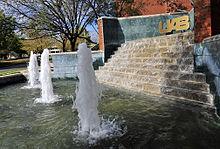
In the 1970s and 1980s, Birmingham's economy was transformed by investments in bio-technology and medical research at the University of Alabama at Birmingham (UAB) and its adjacent hospital. The UAB Hospital is a Level I trauma center providing health care and breakthrough medical research. UAB is now the area's largest employer and the second largest in Alabama with a workforce of about 18,750 as of 2011. Health care services provider HealthSouth, Surgical Care Affiliates and Diagnostic Health Corporation are also headquartered in the city.Caremark Rx was also founded in the city.
Birmingham is also a leading banking center, serving as home to two major banks: Regions Financial Corporation and BBVA Compass. SouthTrust, another large bank headquartered in Birmingham, was acquired by Wachovia in 2004. The city still has major operations as one of the regional headquarters of Wachovia, which itself is now part of Wells Fargo Bank. In November 2006, Regions Financial merged with AmSouth Bancorporation, which was also headquartered in Birmingham. They formed the 8th largest U.S. bank (by total assets). Nearly a dozen smaller banks are also headquartered in the Magic City, such as Superior Bank and (until its failure in 2009 and reformation as Birmingham-based Cadence Bank) New South Federal Savings Bank. As of 2009, the finance & banking sector in Birmingham employed 1,870 financial managers, 1,530 loan officers, 680 securities commodities and financial services sales agents, 380 financial analysts, 310 financial examiners, 220 credit analysts, and 130 loan counselors.
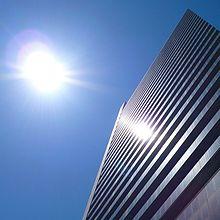
The telephone company that is now owned by AT&T Inc., which was formerly BellSouth and before that South Central Bell, which had its headquarters in Birmingham, has a major nexus in Birmingham, supported by a skyscraper downtown.
The insurance companies Protective Life, Infinity Property & Casualty, ProAssurance, and Liberty National have their headquarters in Birmingham, and these employ a large number of people in Greater Birmingham.
Birmingham is also a powerhouse of construction and engineering companies, including BE&K, Brasfield & Gorrie and B.L. Harbert International which routinely are included in the Engineering News-Record lists of top design and international construction firms.
Two of the largest soft-drink bottlers in the United States, each with more than $500 million in sales per year, are located in Birmingham. The Buffalo Rock Company, founded in 1901, was formerly a maker of just ginger ale, but now it is a major bottler for the Pepsi Cola Company, and the Coca-Cola Bottling Company, United, founded in 1902, is the third-largest bottler of Coca-Cola products in the United States.
The Birmingham metropolitan area has consistently been rated as one of America's best places to work and earn a living based on the area's competitive salary rates and relatively low living expenses. One study published in 2006 at the Web site Salary.com determined that Birmingham was second in the nation for building personal net worth, based on local salary rates, living expenses, and unemployment rates.
A 2006 study by web site bizjournals.com calculated Birmingham's "combined personal income" (the sum of all money earned by all residents of an area in a year) at $48.1 billion.
Birmingham's sales tax, which also applies fully to groceries, stands at 10 percent and is the highest tax rate of the nation's 100 largest cities.
Although Jefferson County's bankruptcy filing was the largest government bankruptcy in United States history, Birmingham remains solvent.
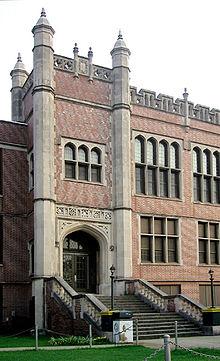
The city of Birmingham is served by the Birmingham City Schools system. It is run by the Birmingham Board of Education with a current active enrollment of 30,500 in 67 schools: seven high schools, 13 middle schools, 33 elementary schools, and nine kindergarten-eighth-grade primary schools.
The Birmingham Public Library with 21 branches serves the entire community to provide education and entertainment for all ages.
The greater-Birmingham metropolitan area is the home of numerous independent school systems, because there has a been a great deal of fragmentation of educational systems in Alabama, and especially in Jefferson County. Some of these "school systems" only have three to five schools. The metropolitan area's three largest school systems are the Jefferson County School System, Birmingham City Schools, and the Shelby County School System. However, there are many, many smaller school systems.
The Birmingham area is reputed to be the home of some of Alabama's best high schools, colleges, and universities. In 2005, the Jefferson County International Baccalaureate School in Irondale, an eastern suburb of Birmingham, was rated as the No. 1 high school in America by Newsweek, a national publication. The school remains among the nation's top 5 high schools. Mountain Brook High School placed 250th on the list. Other local schools that have been rated among America's best in various publications include Homewood High School, Vestavia Hills High School and the Alabama School of Fine Arts located downtown. The metro area also has three highly regarded preparatory schools: Saint Rose Academy located in Birmingham proper The Altamont School, also located in Birmingham proper, and Indian Springs School in north Shelby County near Pelham.
Noteworthy institutions of higher education in greater Birmingham include the University of Alabama at Birmingham, Samford University (includes the Cumberland School of Law), Birmingham School of Law, Miles College, the independent Miles Law School, Jefferson State Community College, Birmingham-Southern College, University of Montevallo (in Shelby County), Lawson State Community College, and Virginia College in Birmingham, the largest career college based in Birmingham.
Before the first structure was built in Birmingham, the plan of the city was laid out over a total of 1,160 acres (4.7 km2) by the directors of the Elyton Land Co. The streets were numbered from west to east, leaving Twentieth Street to form the central spine of downtown, anchored on the north by Capital Park and stretching into the slopes of Red Mountain to the south. A "railroad reservation" was granted through the center of the city, running east to west and zoned solely for industrial uses. As the city grew, bridges and underpasses separated the streets from the railroad bed, lending this central reservation some of the impact of a river (without the pleasant associations of a waterfront). From the start, Birmingham's streets and avenues were unusually wide at 80 to 100 feet (24 to 30 m), purportedly to help evacuate unhealthy smoke.
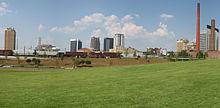
In the early 20th century professional planners helped lay out many of the new industrial settlements and company towns in the Birmingham District, including Corey (now Fairfield) which was developed for the Tennessee Coal, Iron and Railroad Company (subsequently purchased by U.S. Steel). At the same time, a movement to consolidate several neighboring cities gained momentum. Although local referendums indicated mixed feelings about annexation, the Alabama legislature enacted an expansion of Birmingham's corporate limits that became effective on January 1, 1910.
The Robert Jemison company developed many residential neighborhoods to the south and west of Birmingham which are still renowned for their aesthetic quality.
A 1924 plan for a system of parks, commissioned from the Olmsted Brothers is seeing renewed interest with several significant new parks and greenways under development. Birmingham officials have approved a City Center Master Plan developed by Urban Design Associates of Pittsburgh, which advocates strongly for more residential development in the downtown area. The plan also called for a major park over several blocks of the central railroad reservation: Railroad Park, which opened in 2010. Along with Ruffner Mountain Park, and the proposed Red Mountain Park, Birmingham would rank first in the United States for public green space per resident.

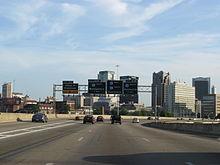
Birmingham has one of the most extensive networks of highways and roadways in the Southeast. The city is served by four Interstate Highways: Interstate 20, Interstate 65, Interstate 59, and Interstate 22, as well as a southern bypass expressway Interstate 459, which connects with I-20/59 to the southwest, with I-65 the south, I-20 to the east, and I-59 to the northeast. Beginning in downtown Birmingham is the "Elton B. Stephens Expressway" aethe Red Mountain Expressway to the southeast aewhich carries both U.S. Highway 31 and U.S. Highway 280 to, through, and over Red Mountain. Interstate 22 is on the verge of completion between Birmingham and Memphis, Tennessee, lacking only the final three to four miles that will connect it with I-65 just north of the Birmingham city limits. There have been proposals and plans for the construction of a Northern Beltline Highway on the opposite side of Birmingham from Interstate 459.
In the area of metropolitan public transportation, Birmingham is served by the Birmingham-Jefferson County Transit Authority (BJCTA) bus, trolley, and paratransit system, which from 1985 until 2008 was branded the Metro Area Express (MAX). BJCTA also operates a "downtown circulator" service called "D A R T" (Downtown Area Runabout Transit), which consists of two routes in the central business district and one in the UAB area.
Birmingham is served by the Birmingham-Shuttlesworth International Airport. This airport serves more than 3 million passengers every year. With more than 160 flights daily, the airport offers flights to 37 cities across the United States. Commercial passenger service through Birmingham is provided by United Express, Delta Air Lines/Delta Connection, American Airlines/American Eagle, US Airways/US Airways Express, and Southwest Airlines.
Birmingham is served by three major railroad freight companies: the Norfolk Southern Company, CSX Transportation, and the BNSF Railway. All three of these have major railroad yards in the metro area. Smaller regional railroads such as the Alabama Warrior Railway and the Birmingham Southern Railroad also freight customers in Birmingham. Amtrak's Crescent connects Birmingham with the cities and towns of Washington, D.C. (and points northeast and northwest of that), Greensboro, NC, Charlotte, N.C., Greenville, SC, Atlanta, Anniston, Alabama, Tuscaloosa, Meridian, Mississippi, Hattiesburg, and New Orleans. For the past several decades, the only passenger railroad service in Birmingham has been the Amtrak Crescent, with one train eastbound and one train westbound daily from the Birmingham Station.
The water for Birmingham and the intermediate urbanized area is served by the Birmingham Water Works Board (BWWB). A public authority that was established in 1951, the BWWB serves all of Jefferson, northern Shelby, western St. Clair counties. The largest reservoir for BWWB is Lake Purdy, which is located on the Jefferson and Shelby County line, but has several other reservoirs including Bayview Lake in western Jefferson County. There are plans to pipeline water from Inland Lake in Blount County and Lake Logan Martin, but those plans are on hold indefinitely.
Jefferson County Environmental Services serves the Birmingham metro area with sanitary sewer service. Sewer rates have increased in recent years after citizens concerned with pollution in area waterways filed a lawsuit that resulted in a federal consent decree to repair an aging sewer system. Because the estimated cost of the consent decree was approximately three times more than the original estimate, many blame the increased rates on corruption of several Jefferson County officials. One major reason for the higher cost was that Jefferson County had to buy the sewers from many smaller municipalities in the area to ensure that these sewers were being maintained in a fashion that would meet EPA approval to avoid massive fines for failure to comply with the consent decree. The sewer construction and bond-swap agreements continue to be a controversial topic in the area.
Electric power is provided primarily by Southern Company-subsidiary, Alabama Power. However, some of the surrounding area such as Bessemer and Cullman are provided by TVA. Bessemer also operates its own water and sewer system. Natural gas is provided by Alagasco, although some metro area cities operate their own natural gas services. The local telecommunications are provided by AT&T. Cable television service is provided by Bright House Networks within the cities of Birmingham and Irondale, and Charter Communications in the rest of metro area.
Based on the 2000 census, there were 242,820 people, 98,782 households, and 59,269 families residing in the city. The population density was 1,619.7 people per square mile (625.4/km2). There were 111,927 housing units at an average density of 746.6 per square mile (288.3/km2). The racial makeup of the city was 62.46% Black, 35.07% White, 0.17% Native American, 0.80% Asian, 0.04% Pacific Islander, 0.62% from other races, and 0.83% from two or more races. 1.55% of the population were Hispanic or Latino of any race.
There were 98,782 households out of which 27.7% had children under the age of 18 living with them, 31.1% were married couples living together, 24.6% had a female householder with no husband present, and 40.0% were non-families. 34.4% of all households were made up of individuals and 10.4% had someone living alone who was 65 years of age or older. The average household size was 2.37 and the average family size was 3.09.
In the city, the population is spread out, with 25.0% under the age of 18, 11.1% from 18 to 24, 30.0% from 25 to 44, 20.4% from 45 to 64, and 13.5% who were 65 years of age or older. The median age was 34 years. For every 100 females there were 85.7 males. For every 100 females age 18 and over, there were 80.4 males.
The median income for a household in the city was $26,735, and the median income for a family was $31,851. Males had a median income of $28,184 versus $23,641 for females. The city's per capita income was $15,663. About 20.9% of families and 24.7% of the population were below the poverty line, including 35.4% of those under age 18 and 18.5% of those age 65 or over.
According to the 2010 U.S. Census:
Suburbs are listed in order of population.
Birmingham has the tenth highest crime rate in the country. U.S. News & World Report ranked Birmingham as the third most dangerous city in the nation for 2011 (only Atlanta and Saint Louis were ranked higher). According to statistics reported to the FBI, Birmingham has the seventh highest murder rate among U.S. cities and is ranked eighteenth in violent crime. The Birmingham-Hoover Metropolitan Statistical Area was ranked as having the 35th highest crime rate in the U.S., out of 347 MSAs ranked. The Birmingham metro area crime rate is in line with other southern MSAs such as Jacksonville, FL, and Charlotte, NC. Recently, the A&E Network series, "The First 48" has filmed episodes with some of the city's homicide detectives.
The downtown district is patrolled by City Action Partnership (CAP), formed in 1995 to increase the perception of safety. Funded by a downtown improvement association, the organization reports a 62% decline in criminal activity within its 109-block area.
Birmingham is the cultural and entertainment capital of Alabama with numerous art galleries in the area including the Birmingham Museum of Art, the largest art museum in the Southeast. Downtown Birmingham is currently experiencing a cultural and economic rejuvenation, with several new independent shops and restaurants opening in the area. Birmingham is also home to the state's major ballet, opera, and symphony orchestra companies such the Alabama Ballet, Alabama Symphony Orchestra, Birmingham Ballet, Birmingham Concert Chorale, and Opera Birmingham.
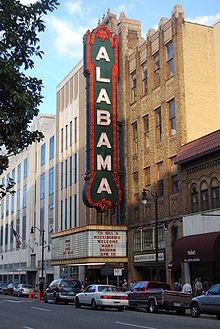
Other entertainment venues in the area include:
Birmingham's nightlife is primarily clustered around Five Points South and Lakeview, but an additional $55-million entertainment district has been approved for an area adjacent to the BJCC.
The Cultural Alliance of Greater Birmingham maintains Birmingham365.org, "a one-stop source for finding out what's going on where around" Birmingham.
Birmingham is home to several museums. The largest is the Birmingham Museum of Art, which is also the largest municipal art museum in the Southeast. The area's history museums includes Birmingham Civil Rights Institute, which houses a detailed and emotionally-charged narrative exhibit putting Birmingham's history into the context of the U.S. Civil Rights Movement. It is located on Kelly Ingram Park adjacent to the 16th Street Baptist Church.
Other history museums include the Southern Museum of Flight, Bessemer Hall of History Sloss Furnaces National Historic Landmark, Alabama Museum of Health Sciences, and the Arlington Home.
The Alabama Jazz Hall of Fame is housed in the historic Carver Theatre, and offers exhibits about the numerous notable jazz musicians from the state of Alabama.
The McWane Science Center is a regional science museum with hands-on science exhibits, temporary exhibitions, and an IMAX dome theater. The center also houses a major collection of fossil specimens for use by researchers. Other unique museums include the Alabama Jazz Hall of Fame, the Barber Vintage Motorsports Museum, with the largest collection of motorcycles in the world, the Iron & Steel Museum of Alabama at Tannehill Ironworks Historical State Park near McCalla, the Alabama Sports Hall of Fame, and the Talladega Superspeedway International Motorsports Hall of Fame museum.
South of downtown on Red Mountain, Vulcan Park features the world's largest cast iron statue, depicting Vulcan at his forge. It was cast for the 1904 St. Louis Exposition, and erected at Vulcan Park in 1938.
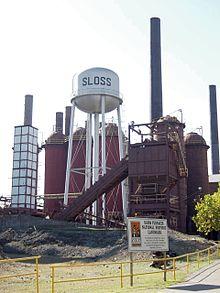
Birmingham is home to numerous cultural festivals showcasing music, films, and regional heritage. Sidewalk Moving Picture Festival brings filmmakers from all over the world to Birmingham to have their films viewed and judged. This festival usually is scheduled on the last weekend in September at eight venues around downtown. Screenings are concentrated at the Alabama Theatre.
Another musical festival is the Taste of 4th Avenue Jazz Festival, presented at the end of September each year, concurrent with the Sidewalk Moving Picture Festival. This all day festival features national and local jazz acts. In 2007, the festival drew an estimated 6,000 people. The Birmingham Folk Festival is an annual event held since 2006. It moved to Avondale Park in 2008. In 2009 the festival featured nine local bands and three touring "headliner bands."
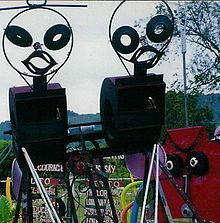
The Southern Heritage Festival began in the 1960s as a music, arts, and entertainment festival for the African-American community to attract mostly younger demographics. Do Dah Day is an annual pet parade held around the end of May. The Schaeffer Eye Center Crawfish Boil, an annual music festival event held in May to benefit local charities, always includes an all-star cast of talent. It typically draws more than 30,000 spectators for the annual two-day event. The annual Greek Festival, a celebration of Greek heritage, culture, and especially cuisine, is a charity fundraiser hosted by the Greek Orthodox Holy Trinity - Holy Cross Cathedral. The Greek Festival draws 20,000 patrons annually. The Lebanese Food Festival is held at St. Elias Maronite Church. Magic City Brewfest is an annual festival benefiting local grassroots organization, Free the Hops, and focusing on craft beer. Alabama Bound is an annual book and author fair that celebrates Alabama authors and publishers. Hosted by the Birmingham Public Library, it is an occasion when fans may meet their favorite authors, buy their books, and hear them read from and talk about their work. Book signings follow each presentation.

The Vulcan statue is a cast iron replica of the Greek/Roman god of fire, iron, and blacksmiths that is the symbol of Birmingham. The statue stands high above the city looking down from a tower at the top of Red Mountain. Open to visitors, the tower offers views of the city below. The Birmingham Zoo is a large regional zoo with more than 700 animals and a recently opened interactive children's zoo.
The Birmingham Botanical Gardens is a 67 acre (270,000 m ²) park displaying a wide variety of plants in interpretive gardens, including formal rose gardens, tropical greenhouses, and a large Japanese Garden. The facility also includes a white-tablecloth restaurant, meeting rooms, and an extensive reference library. It is complemented by Hoover's 30-acre (120,000 m2) Aldridge Botanical Gardens, an ambitious project open since 2002. Aldridge offers a place to stroll, but is to add unique displays in coming years. Splash Adventure (formerly VisionLand and Alabama Adventure) in Bessemer serves as the Birmingham area's water park, featuring numerous slides and water-themed attractions.
Kelly Ingram Park, site of notable civil rights protests and adjacent to historic 16th Street Baptist Church. Railroad Park opened in 2010 in downtown Birmingham's Railroad Reservation District. Oak Mountain State Park is about 10 miles (16 km) south of Birmingham. It is one of the southernmost wrinkles in the Appalachian chain, and a scenic drive to the top provides views reminiscent of the Great Smoky Mountains further north. To the west of the city is located Tannehill Ironworks Historical State Park, a 1,500-acre (6.1 km2) Civil War site which includes the well-preserved ruins of the Tannehill Iron Furnaces and the John Wesley Hall Grist Mill.
The Summit is an upscale lifestyle center with many stores and restaurants. It is located in Southeast Birmingham off of U.S. Highway 280, parallel to Interstate 459. Its anchor tenants are Belk, Saks Fifth Avenue and The North Face.
Birmingham is served by one major newspaper, The Birmingham News (circulation 150,346), which changed from daily to thrice-weekly publication on October 1, 2012. The Birmingham News' Wednesday edition features six sub regional sections named East, Hoover, North, Shelby, South, and West that cover news stories from those areas. The newspaper has been awarded two Pulitzer Prizes, in 1991 and 2007. The Birmingham Post-Herald, the city's second daily, published its last issue in 2006. Other local publications include The North Jefferson News, The Leeds News, The Western Star (Bessemer) and The Western Tribune (Bessemer).
Weld for Birmingham, Birmingham Weekly, Birmingham Free Press and Black & White (published biweekly) are Birmingham's free alternative publications. The Birmingham Times, a historic African-American newspaper, also is published weekly. Birmingham is served by the city magazine of the Chamber of Commerce, Birmingham magazine.
Birmingham is part of the Birmingham/Anniston/Tuscaloosa television market, which is the nation's 40th largest. The major television affiliates, most of which have their transmitters and studios located on Red Mountain in Birmingham, are WBRC 6 (Fox), WBIQ 10 (PBS), WVTM 13 (NBC), WTTO 21 (CW), WBMA 33/40 (ABC), WIAT 42 (CBS), WPXH 44 (ION), and WABM 68 (MyNetworkTV).
Over 45 radio stations serve the Birmingham market, which is the nation's 56th largest radio market. Major broadcasting companies who own stations in the Birmingham market include Clear Channel, Cox Radio, Citadel Broadcasting, and Crawford Broadcasting. The Rick and Bubba show, which is syndicated to over 25 stations primarily in the Southeast, originates from Birmingham's WZZK-FM. The Paul Finebaum sports-talk show, also syndicated and carried nationwide on Sirius digital radio, originates from WJOX.
Birmingham is home to EWTN, the world's largest Catholic media outlet and largest religious network of any kind broadcasting to approximately 118 million homes worldwide.
Birmingham's Sister Cities program is overseen by the Birmingham Sister Cities Commission.
The song "Sweet Home Alabama" by Lynyrd Skynyrd contains the line "In Birmingham they love the governor".
Randy Newman wrote a song, titled "Birmingham", about a man living in this city. It was released as a track on his 1974 album Good Old Boys.
Birmingham is mentioned in "Playboy Mommy" by American singer-songwriter Tori Amos as well as in "Run, baby, run" by American singer-songwriter Sheryl Crow.

Word Count: 7233






